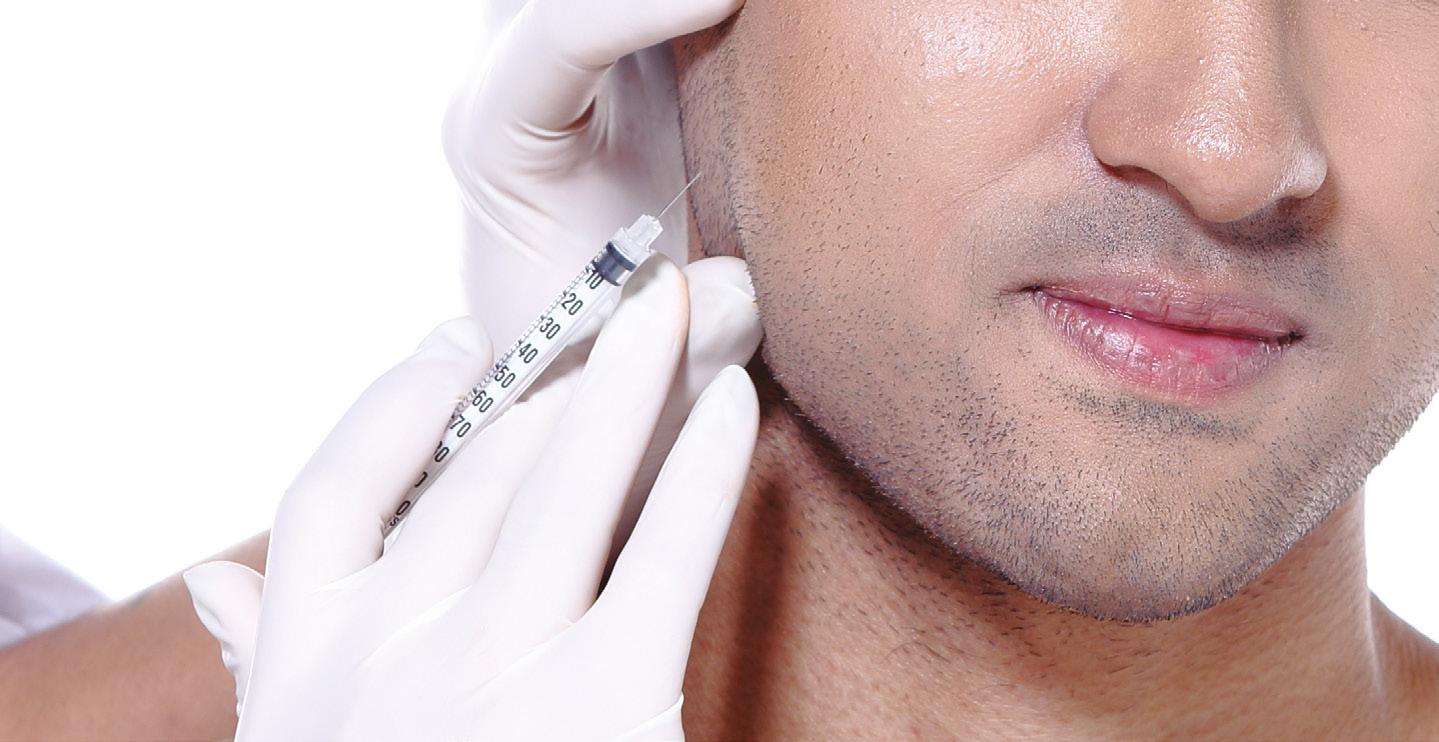
4 minute read
Treating the Male Jawline
Dr David Jack provides his top tips for treating the lower face and jawline using dermal fillers
The jawline is a particularly prominent and defining feature of the male face, with higher muscle bulk, a wider set mandible with a more prominent angle, as well as a wider chin and bulky ramus, when compared to the female jawline.1,2 Most men seeking treatments in my clinic do so for two reasons: antiageing or masculinisation. The former is generally requested by slightly older men who have noticed volume loss and the appearance of jowls, as well as skin changes. The latter tends to be younger men seeking a more defined jawline and wider chin to give a more masculine appearance. Usually, the approach will involve similar treatments regardless of the reason, with supraperiosteal filler placement around the angle of mandible and chin.
Advertisement
Lower facial aesthetics I’m not an advocate for obsessive adherence to aesthetic ‘ideals’, as the ideal jawline will only be ideal in the context of an individual’s face, and ‘correction’ with filler in an attempt to match particular proportions often will result in excessive filling and, more often than not, an odd and unnatural look.
This being said, a 2016 study stated that the ideal male jawline has the following characteristics:3,4 • 130° angle in profile view • Intergonial width that is similar to facial width • Vertical position in frontal view at the oral commissure or at least not below the lower lip • Jawline slope in the facial frontal view nearly parallel to (with a maximum 15° downward deviation from) a line extending from the lateral canthus of the eye to the nasal alae • Ascending ramus slope 65-75° to the Frankfort horizontal line and curvature in the oblique view, visible from earlobe to chin and not pointy
Treatment approach Volume replacement with filler is the key consideration for this area. Any filler injected into the jawline will be subject to substantial deforming forces, particularly if it is injected in the masseteric area. I therefore normally select a filler with a relatively high G-prime (high elasticity and viscosity) and usually choose hyaluronic acid. My technique for the male jawline usually involves deep boluses of filler injected directly onto the periosteum in the region of the angle of the mandible using a needle. The needle would be placed perpendicular to the skin and the product injected only once the needle hits the bone. I always favour a slow approach to injecting, using minimal volumes and building up over time. In terms of product selection, I usually would start with one to two syringes of either Juvéderm Voluma or Volux,5,6 then assess and, if need be, repeat the treatment two weeks to one month later. Voluma would typically be my first choice,5 and I would progress to Volux if it’s not providing enough volumisation after the first sitting.6 Usually, if using two syringes of 1ml, the volume injected would be around 0.30.5ml on each side in two to three points at the angle of the mandible. I generally then use a bolus of around 0.1-0.2ml bilaterally, just anterior to the mandibular retaining ligament, to correct any slight defect there, should there be any. Again, this is a deep injection. Then, I would place a deep bolus onto the surface of the mental process on each side – 0.1-0.2ml – to square the chin if need be. It is sometimes advantageous to use a little bit of filler slightly more superficially in the subcutaneous plane using a cannula along the area of the body of the mandible; however, the need for this varies from patient to patient. I don’t often do this as, frequently, the deeper and lower-risk supraperiosteal injection over the angle of the mandible is sufficient. Injecting superficially in this area is a high-risk procedure, due to the presence of the marginal mandibular branch of the facial nerve and the facial vessels, so should only be attempted by experienced injectors and where there is definite need.
Top tips When treating the male jawline, my advice is to go slowly, using minimal volumes and spreading treatments over several sessions. In my experience, this really is the only way to achieve natural results. I’d usually only do a maximum of two syringes on any patient per appointment, then see the patient at least two weeks later with a view to add more if need be. You should also consider all of the layers of the skin in this area and combine filler with other procedures such as energybased devices like high-intensity focused ultrasound and fractional radiofrequency if needed. These types of treatment can help lift the tissues further and work very nicely in synchrony with revolumisation. Lastly, remember every patient is different and should be treated as such.
This article was produced and funded by Allergan Aesthetics, an AbbVie Company.
For more information go to: www.juvederm.co.uk UK-JUV-2150228 Date of preparation: May 2021
REFERENCES
1. JA Farhadian, et al., Male Aesthetics A Review of Facial
Anatomy and Pertinent Clinical Implications 2015 2. Mommaerts MY The ideal male jaw angle, An Internet survey, J
Craniomaxillofac Surg. 2016 Apr;44(4):381-91 3. Dr David Jack, ‘Contouring the Male Jawline, 2017. <https:// aestheticsjournal.com/feature/contouring-the-male-jawline> 4. Juvéderm VOLUMA DFU 5. Juvéderm VOLUX DFU
Adverse events should be reported. Reporting forms and information can be found at https://yellowcard.mhra.gov.uk/ Adverse events should also be reported to Allergan Ltd. UK_ Medinfo@allergan.com or 01628 494026.










